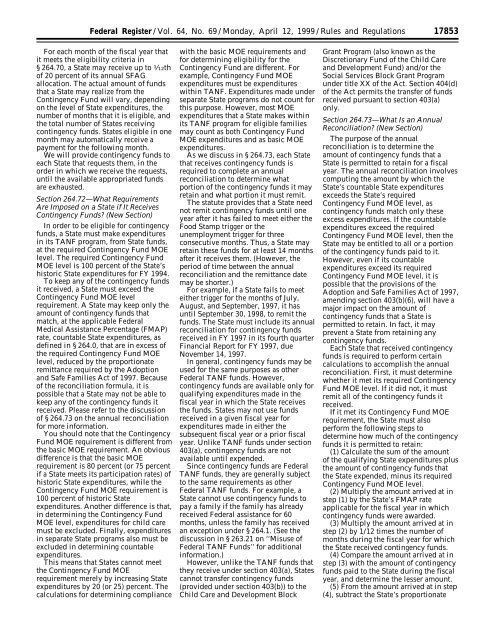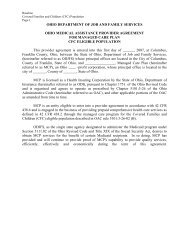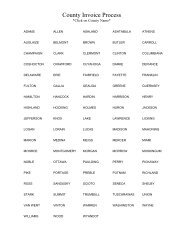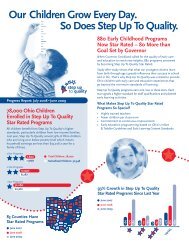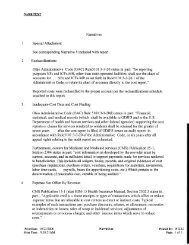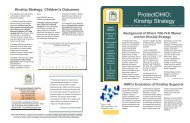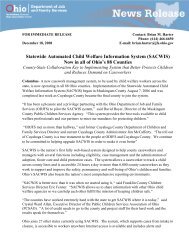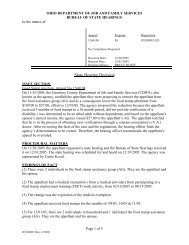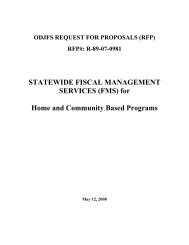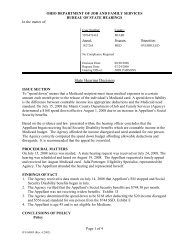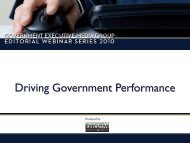Final TANF Rule as published in the Federal Register 4/12/1999
Final TANF Rule as published in the Federal Register 4/12/1999
Final TANF Rule as published in the Federal Register 4/12/1999
Create successful ePaper yourself
Turn your PDF publications into a flip-book with our unique Google optimized e-Paper software.
<strong>Federal</strong> <strong>Register</strong> / Vol. 64, No. 69 / Monday, April <strong>12</strong>, <strong>1999</strong> / <strong>Rule</strong>s and Regulations<br />
For each month of <strong>the</strong> fiscal year that<br />
it meets <strong>the</strong> eligibility criteria <strong>in</strong><br />
§ 264.70, a State may receive up to 1 ⁄<strong>12</strong>th<br />
of 20 percent of its annual SFAG<br />
allocation. The actual amount of funds<br />
that a State may realize from <strong>the</strong><br />
Cont<strong>in</strong>gency Fund will vary, depend<strong>in</strong>g<br />
on <strong>the</strong> level of State expenditures, <strong>the</strong><br />
number of months that it is eligible, and<br />
<strong>the</strong> total number of States receiv<strong>in</strong>g<br />
cont<strong>in</strong>gency funds. States eligible <strong>in</strong> one<br />
month may automatically receive a<br />
payment for <strong>the</strong> follow<strong>in</strong>g month.<br />
We will provide cont<strong>in</strong>gency funds to<br />
each State that requests <strong>the</strong>m, <strong>in</strong> <strong>the</strong><br />
order <strong>in</strong> which we receive <strong>the</strong> requests,<br />
until <strong>the</strong> available appropriated funds<br />
are exhausted.<br />
Section 264.72—What Requirements<br />
Are Imposed on a State if It Receives<br />
Cont<strong>in</strong>gency Funds? (New Section)<br />
In order to be eligible for cont<strong>in</strong>gency<br />
funds, a State must make expenditures<br />
<strong>in</strong> its <strong>TANF</strong> program, from State funds,<br />
at <strong>the</strong> required Cont<strong>in</strong>gency Fund MOE<br />
level. The required Cont<strong>in</strong>gency Fund<br />
MOE level is 100 percent of <strong>the</strong> State’s<br />
historic State expenditures for FY 1994.<br />
To keep any of <strong>the</strong> cont<strong>in</strong>gency funds<br />
it received, a State must exceed <strong>the</strong><br />
Cont<strong>in</strong>gency Fund MOE level<br />
requirement. A State may keep only <strong>the</strong><br />
amount of cont<strong>in</strong>gency funds that<br />
match, at <strong>the</strong> applicable <strong>Federal</strong><br />
Medical Assistance Percentage (FMAP)<br />
rate, countable State expenditures, <strong>as</strong><br />
def<strong>in</strong>ed <strong>in</strong> § 264.0, that are <strong>in</strong> excess of<br />
<strong>the</strong> required Cont<strong>in</strong>gency Fund MOE<br />
level, reduced by <strong>the</strong> proportionate<br />
remittance required by <strong>the</strong> Adoption<br />
and Safe Families Act of 1997. Because<br />
of <strong>the</strong> reconciliation formula, it is<br />
possible that a State may not be able to<br />
keep any of <strong>the</strong> cont<strong>in</strong>gency funds it<br />
received. Ple<strong>as</strong>e refer to <strong>the</strong> discussion<br />
of § 264.73 on <strong>the</strong> annual reconciliation<br />
for more <strong>in</strong>formation.<br />
You should note that <strong>the</strong> Cont<strong>in</strong>gency<br />
Fund MOE requirement is different from<br />
<strong>the</strong> b<strong>as</strong>ic MOE requirement. An obvious<br />
difference is that <strong>the</strong> b<strong>as</strong>ic MOE<br />
requirement is 80 percent (or 75 percent<br />
if a State meets its participation rates) of<br />
historic State expenditures, while <strong>the</strong><br />
Cont<strong>in</strong>gency Fund MOE requirement is<br />
100 percent of historic State<br />
expenditures. Ano<strong>the</strong>r difference is that,<br />
<strong>in</strong> determ<strong>in</strong><strong>in</strong>g <strong>the</strong> Cont<strong>in</strong>gency Fund<br />
MOE level, expenditures for child care<br />
must be excluded. <strong>F<strong>in</strong>al</strong>ly, expenditures<br />
<strong>in</strong> separate State programs also must be<br />
excluded <strong>in</strong> determ<strong>in</strong><strong>in</strong>g countable<br />
expenditures.<br />
This means that States cannot meet<br />
<strong>the</strong> Cont<strong>in</strong>gency Fund MOE<br />
requirement merely by <strong>in</strong>cre<strong>as</strong><strong>in</strong>g State<br />
expenditures by 20 (or 25) percent. The<br />
calculations for determ<strong>in</strong><strong>in</strong>g compliance<br />
with <strong>the</strong> b<strong>as</strong>ic MOE requirements and<br />
for determ<strong>in</strong><strong>in</strong>g eligibility for <strong>the</strong><br />
Cont<strong>in</strong>gency Fund are different. For<br />
example, Cont<strong>in</strong>gency Fund MOE<br />
expenditures must be expenditures<br />
with<strong>in</strong> <strong>TANF</strong>. Expenditures made under<br />
separate State programs do not count for<br />
this purpose. However, most MOE<br />
expenditures that a State makes with<strong>in</strong><br />
its <strong>TANF</strong> program for eligible families<br />
may count <strong>as</strong> both Cont<strong>in</strong>gency Fund<br />
MOE expenditures and <strong>as</strong> b<strong>as</strong>ic MOE<br />
expenditures.<br />
As we discuss <strong>in</strong> § 264.73, each State<br />
that receives cont<strong>in</strong>gency funds is<br />
required to complete an annual<br />
reconciliation to determ<strong>in</strong>e what<br />
portion of <strong>the</strong> cont<strong>in</strong>gency funds it may<br />
reta<strong>in</strong> and what portion it must remit.<br />
The statute provides that a State need<br />
not remit cont<strong>in</strong>gency funds until one<br />
year after it h<strong>as</strong> failed to meet ei<strong>the</strong>r <strong>the</strong><br />
Food Stamp trigger or <strong>the</strong><br />
unemployment trigger for three<br />
consecutive months. Thus, a State may<br />
reta<strong>in</strong> <strong>the</strong>se funds for at le<strong>as</strong>t 14 months<br />
after it receives <strong>the</strong>m. (However, <strong>the</strong><br />
period of time between <strong>the</strong> annual<br />
reconciliation and <strong>the</strong> remittance date<br />
may be shorter.)<br />
For example, if a State fails to meet<br />
ei<strong>the</strong>r trigger for <strong>the</strong> months of July,<br />
August, and September, 1997, it h<strong>as</strong><br />
until September 30, 1998, to remit <strong>the</strong><br />
funds. The State must <strong>in</strong>clude its annual<br />
reconciliation for cont<strong>in</strong>gency funds<br />
received <strong>in</strong> FY 1997 <strong>in</strong> its fourth quarter<br />
F<strong>in</strong>ancial Report for FY 1997, due<br />
November 14, 1997.<br />
In general, cont<strong>in</strong>gency funds may be<br />
used for <strong>the</strong> same purposes <strong>as</strong> o<strong>the</strong>r<br />
<strong>Federal</strong> <strong>TANF</strong> funds. However,<br />
cont<strong>in</strong>gency funds are available only for<br />
qualify<strong>in</strong>g expenditures made <strong>in</strong> <strong>the</strong><br />
fiscal year <strong>in</strong> which <strong>the</strong> State receives<br />
<strong>the</strong> funds. States may not use funds<br />
received <strong>in</strong> a given fiscal year for<br />
expenditures made <strong>in</strong> ei<strong>the</strong>r <strong>the</strong><br />
subsequent fiscal year or a prior fiscal<br />
year. Unlike <strong>TANF</strong> funds under section<br />
403(a), cont<strong>in</strong>gency funds are not<br />
available until expended.<br />
S<strong>in</strong>ce cont<strong>in</strong>gency funds are <strong>Federal</strong><br />
<strong>TANF</strong> funds, <strong>the</strong>y are generally subject<br />
to <strong>the</strong> same requirements <strong>as</strong> o<strong>the</strong>r<br />
<strong>Federal</strong> <strong>TANF</strong> funds. For example, a<br />
State cannot use cont<strong>in</strong>gency funds to<br />
pay a family if <strong>the</strong> family h<strong>as</strong> already<br />
received <strong>Federal</strong> <strong>as</strong>sistance for 60<br />
months, unless <strong>the</strong> family h<strong>as</strong> received<br />
an exception under § 264.1. (See <strong>the</strong><br />
discussion <strong>in</strong> § 263.21 on ‘‘Misuse of<br />
<strong>Federal</strong> <strong>TANF</strong> Funds’’ for additional<br />
<strong>in</strong>formation.)<br />
However, unlike <strong>the</strong> <strong>TANF</strong> funds that<br />
<strong>the</strong>y receive under section 403(a), States<br />
cannot transfer cont<strong>in</strong>gency funds<br />
(provided under section 403(b)) to <strong>the</strong><br />
Child Care and Development Block<br />
17853<br />
Grant Program (also known <strong>as</strong> <strong>the</strong><br />
Discretionary Fund of <strong>the</strong> Child Care<br />
and Development Fund) and/or <strong>the</strong><br />
Social Services Block Grant Program<br />
under title XX of <strong>the</strong> Act. Section 404(d)<br />
of <strong>the</strong> Act permits <strong>the</strong> transfer of funds<br />
received pursuant to section 403(a)<br />
only.<br />
Section 264.73—What Is an Annual<br />
Reconciliation? (New Section)<br />
The purpose of <strong>the</strong> annual<br />
reconciliation is to determ<strong>in</strong>e <strong>the</strong><br />
amount of cont<strong>in</strong>gency funds that a<br />
State is permitted to reta<strong>in</strong> for a fiscal<br />
year. The annual reconciliation <strong>in</strong>volves<br />
comput<strong>in</strong>g <strong>the</strong> amount by which <strong>the</strong><br />
State’s countable State expenditures<br />
exceeds <strong>the</strong> State’s required<br />
Cont<strong>in</strong>gency Fund MOE level, <strong>as</strong><br />
cont<strong>in</strong>gency funds match only <strong>the</strong>se<br />
excess expenditures. If <strong>the</strong> countable<br />
expenditures exceed <strong>the</strong> required<br />
Cont<strong>in</strong>gency Fund MOE level, <strong>the</strong>n <strong>the</strong><br />
State may be entitled to all or a portion<br />
of <strong>the</strong> cont<strong>in</strong>gency funds paid to it.<br />
However, even if its countable<br />
expenditures exceed its required<br />
Cont<strong>in</strong>gency Fund MOE level, it is<br />
possible that <strong>the</strong> provisions of <strong>the</strong><br />
Adoption and Safe Families Act of 1997,<br />
amend<strong>in</strong>g section 403(b)(6), will have a<br />
major impact on <strong>the</strong> amount of<br />
cont<strong>in</strong>gency funds that a State is<br />
permitted to reta<strong>in</strong>. In fact, it may<br />
prevent a State from reta<strong>in</strong><strong>in</strong>g any<br />
cont<strong>in</strong>gency funds.<br />
Each State that received cont<strong>in</strong>gency<br />
funds is required to perform certa<strong>in</strong><br />
calculations to accomplish <strong>the</strong> annual<br />
reconciliation. First, it must determ<strong>in</strong>e<br />
whe<strong>the</strong>r it met its required Cont<strong>in</strong>gency<br />
Fund MOE level. If it did not, it must<br />
remit all of <strong>the</strong> cont<strong>in</strong>gency funds it<br />
received.<br />
If it met its Cont<strong>in</strong>gency Fund MOE<br />
requirement, <strong>the</strong> State must also<br />
perform <strong>the</strong> follow<strong>in</strong>g steps to<br />
determ<strong>in</strong>e how much of <strong>the</strong> cont<strong>in</strong>gency<br />
funds it is permitted to reta<strong>in</strong>:<br />
(1) Calculate <strong>the</strong> sum of <strong>the</strong> amount<br />
of <strong>the</strong> qualify<strong>in</strong>g State expenditures plus<br />
<strong>the</strong> amount of cont<strong>in</strong>gency funds that<br />
<strong>the</strong> State expended, m<strong>in</strong>us its required<br />
Cont<strong>in</strong>gency Fund MOE level.<br />
(2) Multiply <strong>the</strong> amount arrived at <strong>in</strong><br />
step (1) by <strong>the</strong> State’s FMAP rate<br />
applicable for <strong>the</strong> fiscal year <strong>in</strong> which<br />
cont<strong>in</strong>gency funds were awarded.<br />
(3) Multiply <strong>the</strong> amount arrived at <strong>in</strong><br />
step (2) by 1/<strong>12</strong> times <strong>the</strong> number of<br />
months dur<strong>in</strong>g <strong>the</strong> fiscal year for which<br />
<strong>the</strong> State received cont<strong>in</strong>gency funds.<br />
(4) Compare <strong>the</strong> amount arrived at <strong>in</strong><br />
step (3) with <strong>the</strong> amount of cont<strong>in</strong>gency<br />
funds paid to <strong>the</strong> State dur<strong>in</strong>g <strong>the</strong> fiscal<br />
year, and determ<strong>in</strong>e <strong>the</strong> lesser amount.<br />
(5) From <strong>the</strong> amount arrived at <strong>in</strong> step<br />
(4), subtract <strong>the</strong> State’s proportionate


